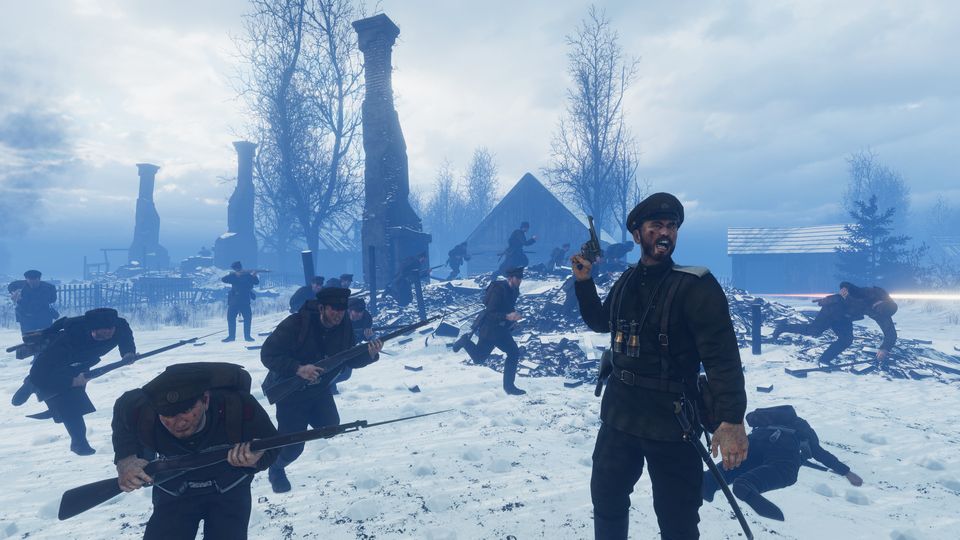All the informations you need to get started in Tannenberg. Also suitable for veterans of the Western Front.
Battles on the Eastern Front and how they differ from the Western Front
Welcome to the Eastern Front. In this guide, I will try to give veterans of Verdun and players that are completely new to M2Hs WW1 series an idea of what to expect in Tannenberg. This is not an in-depth guide nor is it a complete squad/role overview.
The main gamemode in Tannenberg is called Maneuver , as opposed to the static trenchwar on the Western Front. This means that there is no designated attacker/defender during the match, so players can freely decide where to move, when to defend and when to attack. I’d highly recommend working together with your squad – This is now even more important than in Verdun, since squadmembers can support each other with various abilities.
Back to the Maneuver: The battlefield is divided into sectors, which can be captured by the teams and provide a bonus in return. This bonus can range from quicker spawning to ammo supply or improved NCO abilities – We will get to that later.
Each team starts with 2000 Victory Points, which are drained when the enemy has more sectors under their control than they have. Sectors marked with a star count more on the Victory Point calculation than other sectors.
“So my efforts should be focused on the Star Sectors, right?”
True, but be careful not to lose your flanks. You DON’T want to be attacked by three sides at once. Maneuver is – who could have guessed – all about maneuvering, knowing when and where to strike and when it’ better to hold the advance and dig in.
Speaking of defending, there are no LMGs in Tannenberg. Instead, Heavy MGs are spread throughout the map that can be used by anyone and resupplied with ammo by some roles. On the bottom right corner of the HUD, you can see your amount of MG bullets above your grenade counter.
Squads
Tanneberg currently features six different squads, three on each side. They all have a unique loadout available, with some weapons being used by multiple squads – For example, the Bulgarians sometimes use the same rifle as Austria-Hungary.
Squads are divided into different types, named Infantry, Assault and Support . Each type has different NCO-abilities.
The NCO of an Infantry-Squad can call in artillery, An Assault-NCO can call Gas. Recon planes are available for a Support-Squad. All NCOs – regardless of their squad type – can call in a smoke grenade instead of their normal ability.
You can level up your squad by playing with the same players over and over again, this will level up your perks and provide you with fancy new uniforms.
Roles
Each squad has four roles that come with perks and three different loadouts to choose from. Much like the armament, some perks are available for roles in different squads.
Unlike in Verdun, there is barely a difference between the roles the squads posses.
NCO
Despite no longer being the mobile-spawn point that he has been in Verdun (You can spawn on ANY of your squad members, kinda like Chasseur Alpine, Highlanders and Alpenjäger in Verdun), the NCO is still an important role.
As in Verdun, you can open the ability Menu with Q , then set an attack/defense order with left click. Use this to give your squad a goal, works surprisingly well, even with random players. If you played Verdun, you may wonder why you can’t find your NCO-ability.
They basically removed telepathic-support-calls, which means you now have to go to a telephone or your squads supporter to call in anything. Telephones can be found in any sector your team is currently holding.
Rifleman
As their name suggests, they are mostly armed with rifles or carbines. Their perks often give them a bonus for hip-firing, melee or long-range shots. A basic and versatile class.
Supporter
Instead of a Machine Gunner, every squad now has a supporter class which can have different abilities to resupply their teammates or help their NCO call in support. As other roles, the supporter also has three perks, with two of them being support-related. Those supporter perks can be divided into active and passive , with active perks requiring you to place your crate/telephone by pressing Q and left clicking.
Active perks:
- Bullet Ammunition Crate – Allows allies ro refill their bullets.
- Grenade Ammunition Crate – Allows allies ro refill their grenades.
- Field Telephone – Allows you to place a telephone the NCO can interact with.
Passive perks:
- Pigeon Carrier – Allows the NCO to interact with you as if you were a telephone.
- Bullet Ammunition Carrier – Teammates can resupply their bullets when you are nearby.
- Grenade Ammunition Carrier – Teammates can resupply their grenades when you are nearby.
Grenadier
The grenadier has a versatile loadout, as a rule of thumb you can say: The smaller your main weapon, the more grenades you carry.
A nightmare for enemy fortifications. Depending on your squad, you may get perks for throwing grenades faster, longer or don’t slow down as much when you throw them while sprinting.
Those are the four roles you have in this game. You will find that most roles – regardless of the squad they belong to- play out quite similar.
I personally think that supporters that have either Field Telephone or Pigeon Carrier are the best, but that’s only me as an NCO speaking. Bullet resupply can be necessary at times, since you only spawn with 50 bullets instead of 100, but this should be rather rare unless you’re mostly playing against bots.
Anyway, those are my thoughts on the game, any criticism or ideas are welcome.
